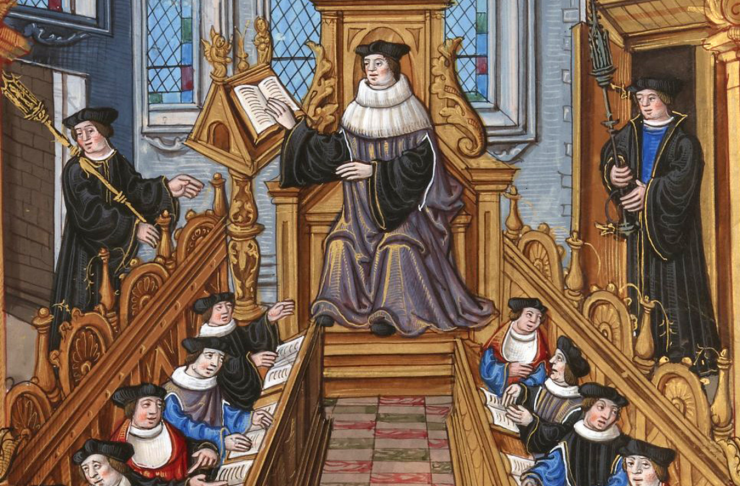The reaction to Pierre Duhem’s 1913 volume Le système du monde: histoire des doctrines cosmologiques de Platon à Copernic (The System of World: A History of Cosmological Doctrines from Plato to Copernicus) was both strong and spectacular. His work provided undeniable evidence that in the Middle Ages faith in the predictability of nature was rooted in the theology of God as the Creator of Heaven and Earth. It was not just a single belief, but a climate of shared belief nurtured by an educational system comprised of universities, cathedral schools, and monasteries that consistently taught Christian theology. Circumnavigate the conclusion however one may, the theological beliefs that united the consistent learning centers teaching those beliefs did not exist in any of the ancient cultures nor did the Scientific Revolution occur in them.
The people in ancient cultures had the skills to produce a viable science of physical laws and systems of laws, but they held some form of a pantheistic or animistic worldview. The worldview instilled by the Old Testament cultures was founded on the theology of a personal and merciful God who created a universe of order and routine. In early Christianity, from the first millennium and into the second, and even now, this worldview was maintained. It was maintained when the Greek works were introduced and translated to the Christian West in the Middle Ages. It was the Christian scholars who dared to reject certain long-held ideas from the ancient Greeks because those ideas contradicted the tenets of Divine Revelation. The significance of the difference in the Christian worldview and the pantheistic worldview is critical to the birth of modern science. Fr. Stanley L. Jaki named the “classical and most influential case” that represents the birth of modern science from Christianity, and this is the case of Fr. Jean Buridan (1300–1358), the French priest who developed the concept of the impetus which led to the modern concept of inertia and paved the way for Isaac Newton’s first law of motion.
Jean Buridan’s Impetus Theory
In his work Quaestiones super quattuor libris de Cælo et Mundo, Buridan showed that a radical departure from Aristotelian cosmology and physics was absolutely necessary for explaining the movement of bodies. Buridan not only departed from untenable ideas, he affirmed his faith in the Creator and derived from those “articles of faith” what could only be known by revelation and not by scientific demonstration. Buridan stated that “in many an instance one should not believe Aristotle who made many propositions contrary to the Catholic faith because he wanted to state nothing except what could be derived from considerations based on what is seen and experienced.” (Quaestiones, p. 152) Stated more concisely—and this should be considered carefully—it was faith, not observation, experimentation, or investigation that gave the first breaths to modern science.
Buridan’s theory of impetus is found in Book VIII, Question 12 of Super octo libros physicorum Aristotelis subtilissimae quaestiones. He was thinking about what moves a projectile after it leaves the hand of the projector. It is first necessary to understand what Aristotle asserted, which was the accepted explanation in Buridan’s day, so first a brief review.
Aristotle’s Theory of Motion
Aristotelian theory of motion held that terrestrial bodies had a natural motion towards the center of the universe, which meant, at that time, the center of earth. Motion in any other direction was “violent” motion because it contradicted natural motion and thus, required a mover to move it. Bodies were thought to naturally desire rest, so whenever something moved in any other way than naturally, there had to be a mover in contact with it. If the mover ceased to move it, the body fell straight to the earth and became suddenly at rest. Aristotle also argued that if the resistance of a medium through which an object passed remained constant, the body would move at a constant speed if the force exerted by the mover were also constant. [This is false. A constant force results in a proportionally constant acceleration (F=ma) according to Newton’s second law.]
Aristotle also held that if the resistance of the medium varied, the speed the object moved under constant force varied proportionally, and if the movement took place in a vacuum, bodies would move instantaneously with infinite speed. This is one of the reasons why Aristotle thought a complete void was impossible. Aristotle’s system included an explanation in Book VII and VIII of Physics, and Book III of De cælo that objects move farther when thrown due to a concept he coined as antiperistasis, which means a surrounding (peri) resistance (anti) caused by an action that induces an unchanging equilibrium (stasis). This concept applied to projectiles (thrown objects). Once the mover (the hand, for instance) throws the object and the object is no longer in contact with the mover, the air that resists the object (anti) is divided by the object and surrounds it (peri). By doing so, the air fills in the vacuum in the wake thereby impelling it along (stasis). When bodies fall to the ground, Aristotle attributed this natural motion to the soul of the object (animism) searching for what is best for it. Thus a ball thrown on earth will be impelled by antiperistasis, but will also be acted upon by the ball’s nature which searches for the ground, thus projectile motion.
According to Aristotle, the mass of an object is directly proportional to the nature of the object’s desire for its natural place. Therefore, Aristotle thought that two otherwise identical objects would fall to the ground with proportionally different speeds if one was twice the mass of the other, the heavier one falling twice as fast as the lighter one. The heavier mass’s larger nature held a larger desire to be on the ground, a conclusion that defies plain common sense and observation. It is easily observed that two balls of different mass fall at the same rate of acceleration, but this was not noticed or not admitted by the ancient Greeks or by the Muslims who followed Aristotle. Note, he was not referring to two dissimilar objects such as a feather and a ball which would fall at rates also affected by surface area and air resistance. Aristotle was referring to objects identical except for mass, i.e. two balls of the same size but different masses.
According to Aristotle, there were two kinds of bodies: terrestrial (natural) and celestial (divine). The terrestrial bodies moved toward their desired place of rest. The celestial bodies were the bodies from the Moon upward, and they moved in a circle in a sort of divine substance called the ether. This explained why the heavenly realm moved in continuous circles. They were in a perpetual contact with the Prime Mover itself, which is the basis of the doctrine of eternal cycles (the Great Year) of an eternal cosmos emanating from the Prime Mover. Thus, motion was explained in the heaven and on earth by the object dividing the substance (air or water on earth, the ether in the heavens) and the substance in turn filling in behind the object to push it along. On earth, objects also fell to the ground in search of their rest unless a mover kept them in their motion. In the heavens, bodies were in their most desired place as long as they were in contact with the Prime Mover.
Reconciling with the Christian Creed
Buridan, along with the other Christian scholars reconciling Aristotelian texts with the Creed, rejected the doctrine of the Great Year and eternal cycles of the universe. Because he viewed the universe as the creation of a rational Creator and thus viewed the universe as having an absolute beginning in time, Buridan, in thinking scientifically, necessarily had to ponder the cause of motion for heavenly bodies, which in turn meant he had to ponder the cause of motion for terrestrial bodies, and he did so in the same atmosphere in which the Condemnations of 1277 were made.
So, in Book VIII, Question 12 of the above mentioned work, Buridan appealed to common experience and judged Aristotle’s position to be unsatisfactorily solved. (The question can be found here at Professor Gyula Klim’s site.) Buridan gave the example of a child’s toy, the top. When a top spins, it spins in place so there is no vacuum left behind and thus no antiperistatic effect to impel the top to keep spinning. As a second example, he described the “smith’s wheel” and how it also moves in a circular motion but does not leave a vacuum. As a third example, he pointed out that if an arrow were sharp at both ends, it would still move in the same way as it would move if the back end were blunt. If the motion were caused by the impulsion of the air moving in behind the arrow as it pierced the air, the arrow with a sharp posterior should not fly as far, but this is not observed.
As a fourth example, he described the scenario of a ship moving through water. If the ship is going against the flow and the rowing is stopped, the ship continues on for a while and does not stop immediately. A sailor on deck, however, does not feel the air behind him pushing (impelling) him. He instead feels only the air in front of him resisting him. And if the man were standing at the back of the ship, the strong force from the air rushing in behind the ship and pushing it along ought to knock the man violently into the cargo. Experience shows in all of these scenarios that antiperistasis is false.
Buridan then argued that if, fundamentally, motion is maintained by continuous contact with a mover, then there is no explanation for how the top or the smith’s wheel can continue to move after the hand is removed, for even if a cloth surrounds the top or the wheel on all sides blocking any movement of air, it still spins after the hand is removed. Further, he argued, common experience shows that when a person pushes his hand through the air, he does not feel the air behind his hand pushing it along whether he has a stone in it or not. Buridan concluded that since, in those cases, there is no air to impel motion, no hand to sustain it, no rowing to move it, there must be another explanation. This is how he arrived at his impetus theory (see paragraph 6):
Thus we can and ought to say that in the stone or other projectile there is impressed something which is the motive force (virtus motiva) of that projectile. And this is evidently better than falling back on the statement that the air continues to move that projectile. For the air appears rather to resist. Therefore, it seems to me that it ought to be said that the motor in moving a moving body impresses (imprimit) in it a certain impetus or a certain motive force (vis motiva) of the moving body, [which impetus acts] in the direction toward which the mover was moving the moving body, either up or down, or laterally, or circularly. And by the amount the motor moves that moving body more swiftly, by the same amount it will impress in it a stronger impetus.
The impetus continues to move a stone after the hand throws it, and the impetus is continually decreased by the resisting air and by the gravity of the stone. He also related impetus to mass:
Hence by the amount more there is of matter, by that amount can the body receive more of that impetus and more intensely (intensius). Now in a dense and heavy body, other things being equal, there is more of prime matter than in a rare and light one. Hence a dense and heavy body receives more of that impetus and more intensely, just as iron can receive more calidity than wood or water of the same quantity. Moreover, a feather receives such an impetus so weakly (remisse) that such an impetus is immediately destroyed by the resisting air. And so also if light wood and heavy iron of the same volume and of the same shape are moved equally fast by a projector, the iron will be moved farther because there is impressed in it a more intense impetus, which is not so quickly corrupted as the lesser impetus would be corrupted. This also is the reason why it is more difficult to bring to rest a large smith’s mill which is moving swiftly than a small one, evidently because in the large one, other things being equal, there is more impetus.
Tying this reasoning to common experience, Buridan also explained that this is why one who wishes to jump a longer distance takes a few steps back to run faster and drive himself farther, and why the jumper does not feel the air propelling him but rather the air in front of him resisting him against the force of his jump.
Guided by Faith
Finally, Buridan turned this path of reasoning toward the heavens and noted that the Bible does not claim that God had to keep his hand on the celestial bodies to maintain their motion. Buridan suggested that the motion of celestial bodies could be answered another way.
God, when He created the world, moved each of the celestial bodies as He pleased, and in moving them He impressed in them impetuses which moved them without His having to move them any more except by the method of general influence whereby He concurs as a co-agent in all things which take place; “for thus on the seventh day He rested from all work which He had executed by committing to others the actions and the passions in turn.” And these impetuses which He impressed in the celestial bodies were not decreased nor corrupted afterwards, because there was no inclination of the celestial bodies for other movements. Nor was there resistance which would be corruptive or repressive of that impetus.
In other words, Buridan introduced the concepts that would lead to Newton’s first law of motion, that a body at rest would stay at rest and a body in motion would stay in motion with the same speed and in the same direction unless acted upon by another force. The pantheistic worldview never would have led to such an idea because it was fundamentally and institutionally opposed to it. Buridan’s insight derived from his faith in the Christian Creed, Divine Revelation applied to reason and observation, which led to exact science as a self-sustaining enterprise of physical laws and systems of laws. “I might seek from the theological masters what they might teach me in these matters as to how these things take place.”
Following the Condemnations of 1277 by Tempier against a set of tenets upheld by Aristotle and his followers, a large movement appeared that liberated Christian thought from the ancient Greek thought and produced modern science. Duhem is considered to have identified the 1277 articles as the most significant event in the birth of modern science, while Jaki highlighted the spark ignited by Buridan a generation later. For Jaki, however, it is not a certain man, event, or date that marks the birth of science though; it is a breakthrough in a naturalistic worldview that rejected the pantheistic doctrine of eternal cycles and approached the investigation of nature guided by the light of Christian faith in a merciful, faithful God who created the world out of nothing with an absolute beginning and end in time, that is ordered, predictable, and stable, but also not a god itself. This breakthrough, just described, was based not on observation or experiment but on divine revelation and faith, and it is thus the birth of modern science, a fundamental departure from the worldviews in which modern science was stillborn.
Sources and Recommended Reading
- Stanley Jaki, Science and Creation: From Eternal Cycles to an Oscillating Universe. Edinburgh: Scottish Academic Press, 1986, see pp. 230-231.
- Stanley Jaki, A Late Awakening and Other Essays. Port Huron, MI: Real View Books, 2004.
- Herbert Butterfield, The Origins of Modern Science (New York: The Free Press, A Division of Simon & Schuster Inc., 1957).
- Marshall Clagett, The Science of Mechanics in the Middle Ages (Madison,WI, The University of Wisconsin Press, 1959).
- Pierre Duhem, Essays in the History and Philosophy of Science, Translated and Edited by Roger Ariew and Peter Barker (Indianapolis, IN: Hackett Publishing Company, 1996).
Adapted from my book, Science Was Born of Christianity: The Teaching of Fr. Stanley L. Jaki. Available on Amazon.














